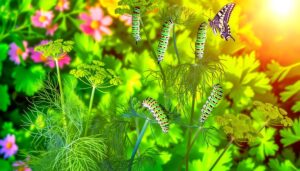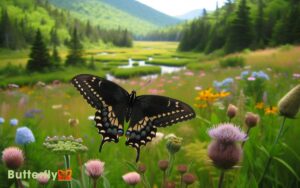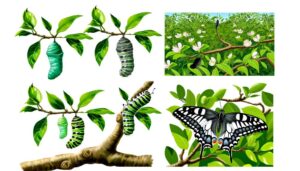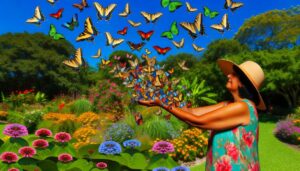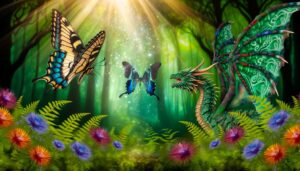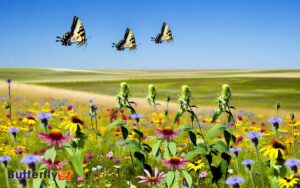Why Is a Picture of a Yellow Swallowtail Butterfly So Captivating?
The Yellow Swallowtail Butterfly (Papilio machaon) is noted for its stunning yellow and black wing patterns, inhabiting temperate regions including open woodlands and river valleys. This species exhibits territorial behavior and displays site fidelity, essential for feeding and oviposition.
Ideal observation occurs from late spring to early summer, particularly in temperatures ranging from 18-30°C. Capturing this butterfly's intricate details requires specialized photographic equipment such as macro lenses and tripods.
Proper composition involves the Rule of Thirds and shallow depth of field, while editing techniques like color correction enhance visual clarity. Understanding these aspects can lead to scientifically rich and visually engaging photography.
Key Takeaways
- Yellow Swallowtail butterflies are often found in temperate regions with open woodlands and meadows.
- They have distinct yellow and black wing patterns that are ideal for close-up macro photography.
- Their peak activity occurs from late spring through early summer, making it the best time for observation.
- Use the Rule of Thirds and contrasting backgrounds to highlight their wings in photographs.
Habitat and Behavior
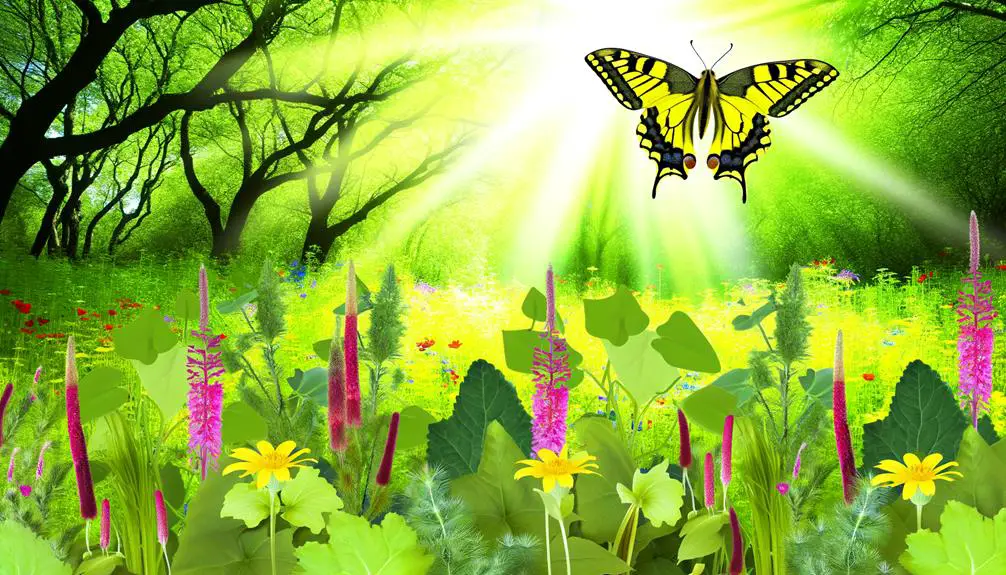
The Yellow Swallowtail butterfly (Papilio machaon) primarily inhabits temperate regions, favoring open woodlands, meadows, and river valleys where host plants are abundant.
This species exhibits a strong preference for areas rich in Apiaceae family plants, such as wild carrots and parsley, which serve as larval food sources.
Adult Yellow Swallowtails demonstrate territorial behavior, frequently patrolling their chosen habitats and engaging in aerial displays to ward off intruders.
Their flight patterns are characterized by a distinct, graceful flutter, facilitating efficient exploration of nectar resources.
Behavioral observations indicate that these butterflies exhibit a high degree of site fidelity, often returning to the same locations for feeding and oviposition.
Their adaptability to diverse microhabitats underscores their resilience and ecological significance.
Best Times to Spot
Ideal periods for observing Yellow Swallowtail butterflies typically occur during late spring through early summer when adult emergence peaks. This time window aligns with the butterflies' life cycle, ensuring a high probability of sightings. Monitoring these periods can greatly enhance field observations and research outcomes.
Below is a detailed table summarizing the best months and corresponding environmental conditions for Yellow Swallowtail sightings:
| Month | Temperature Range (°C) | Activity Level |
|---|---|---|
| May | 18-24 | High |
| June | 20-28 | Peak |
| July | 22-30 | Moderate to High |
| Early August | 24-32 | Declining |
| Late August | 22-28 | Low |
The table delineates the correlation between temperature and butterfly activity, aiding in precise planning for enthusiasts and researchers.
Photography Equipment
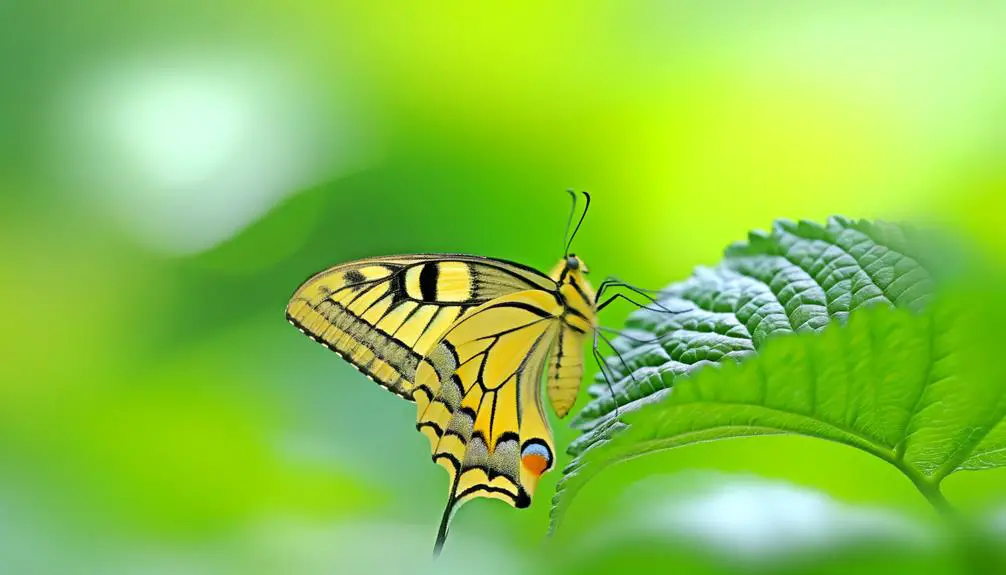
Selecting appropriate photography equipment is vital for capturing high-quality images of Yellow Swallowtail butterflies in their natural habitat. Detailed observation and precise classification require tools that enhance clarity and depth.
Consider the following equipment:
- Macro Lens: Provides magnification and detailed close-ups, revealing intricate wing patterns.
- Tripod: Stabilizes the camera, reducing motion blur, and allowing for longer exposure times.
- Telephoto Lens: Enables distance shots without disturbing the butterfly, essential for natural behavior documentation.
- External Flash: Offers controlled lighting, highlighting the butterfly's vibrant colors without overexposure.
Utilizing these tools guarantees that each photograph encapsulates the essence of the butterfly's environment and behavior, satisfying an audience that values both freedom and scientific accuracy in their quest for natural beauty.
Composition Tips
Mastering composition techniques is essential for producing visually compelling and scientifically accurate images of Yellow Swallowtail butterflies.
Employ the Rule of Thirds to position the butterfly off-center, enhancing dynamic balance.
Capture the Papilio glaucus against contrasting backgrounds to accentuate its vibrant yellow and black wing patterns.
Use a shallow depth of field (aperture f/2.8 to f/5.6) to isolate the subject from the background, highlighting intricate details like the iridescent scales and antennae.
Incorporate natural elements such as flowers or foliage to provide ecological context and scale.
Guarantee the butterfly's eyes and proboscis are in sharp focus, as these anatomical features are critical for scientific documentation.
This approach yields both aesthetically pleasing and informative images.
Editing Techniques
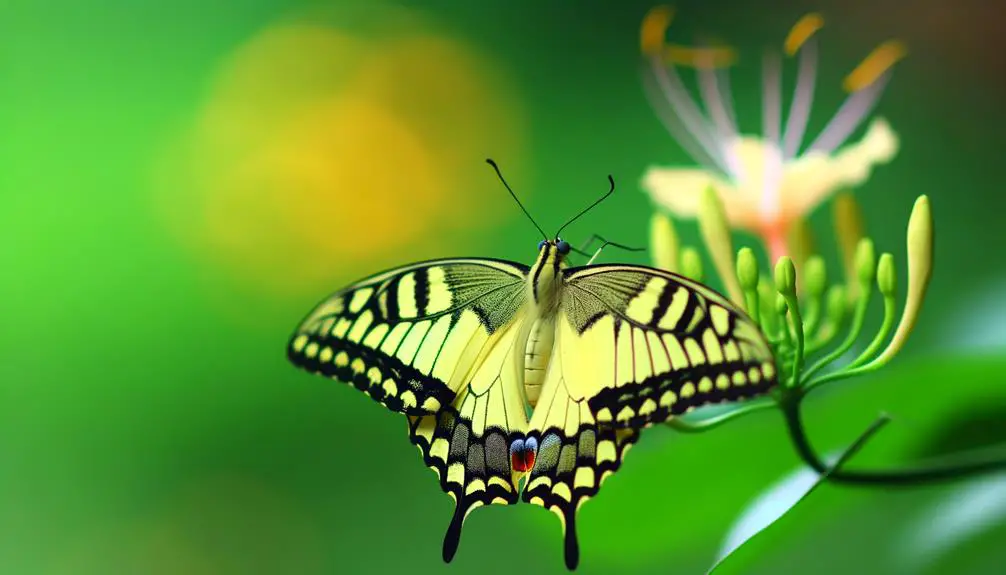
Effective editing techniques are essential for refining the visual and scientific quality of images capturing the Yellow Swallowtail butterfly. High-resolution images require meticulous adjustments to enhance both aesthetic appeal and biological accuracy.
Key editing techniques include:
- Color Correction: Adjust hues to guarantee the butterfly's distinctive yellow and black pattern is accurately represented.
- Noise Reduction: Minimize digital noise to maintain the clarity of intricate wing details.
- Sharpness Enhancement: Apply selective sharpening to emphasize the venation and texture of the wings without introducing artifacts.
- Background Adjustment: Isolate the subject by smoothing or blurring the background, which highlights the butterfly and reduces distractions.
These techniques collectively guarantee that images serve both artistic and scientific purposes, providing viewers with both beauty and precise information.
Symbolism and Meaning
The Yellow Swallowtail butterfly, often imbued with rich symbolic meaning, represents transformation, hope, and the intricate beauty of nature across various cultures and scientific narratives.
In lepidopterology, Papilio glaucus, the Eastern Tiger Swallowtail, epitomizes metamorphosis, embodying the profound process of change from larva to adult. This transformation aligns with human aspirations for growth and renewal.
Culturally, this butterfly is seen as a harbinger of positive change and a sign of resilience. Its vibrant yellow and black pattern, resulting from precise pigmentation and structural coloration, underscores the complexity of natural design.
In indigenous traditions, it often signifies joy and the ephemeral nature of life. Consequently, the Yellow Swallowtail stands as a symbol of both the cyclical nature of life and the perpetual quest for freedom.
Conclusion
The yellow swallowtail butterfly, an epitome of lepidopteran splendor, exemplifies a pinnacle of evolutionary adaptation and visual allure. Its striking black-striped wings contrast beautifully against its vibrant yellow background, making it a mesmerizing sight in gardens and meadows. The swallowtail butterfly features elongated tails on its hindwings, which resemble the forked tail of a swallow and serve as a defense mechanism against predators. This remarkable insect thrives in diverse habitats, showcasing its resilience and adaptability across various environments.
Its dazzling presence, captured through meticulous photography, demands an arsenal of advanced equipment and refined compositional acumen.
The intricate symbolism and profound cultural significance of this butterfly further elevate its stature within the natural world.
Mastery of editing techniques accentuates its ethereal beauty, ensuring that each image transcends mere representation to become a timeless proof of nature's unparalleled artistry.

